RESUME (click + to expand)
EDUCATION
BFA, 1981, United States International University, San Diego
BFA, 1986, Art Center College of Design, Pasadena
FACULTY
1987-1993, Loyola Marymount University
2005-2007, Art Center College of Design, Maestro’s Fine Arts Program in South LA
EXHIBITIONS
2021
The House That Art Built, May 18, 2021, The OCMA Visionaries, Orange County, California
2019
February 2018 – April 2020 – Tacoma Art Museum, Tacoma Washington
March 2019 – Inaugural Exhibition, Melissa Morgan Fine Art, Palm Desert, CA
June 2019 – COLECTIVA, saltfineart. Laguna Beach, CA
November 2019 – Abmeyer + Wood Fine Art, Solo Exhibition, Seattle WA
2018
Victor Hugo Zayas, 15 Year Retrospective, saltfineart, Laguna Beach, CA, February 1 – March 30, 2018
Tacoma Art Museum, February 2018 – June 2020
Formalist to Street Art, Bruno David Gallery, curated by Andi Campognone, September 2018
COLOR VISION, Huntington Beach Fine Art Center, May 5 – June 16, 2018
2017
September 2017 – L.A Painting: Formalism to Street Art, Curated by Andi Campognone, Bruno David, St, Louis, MO
November 2017 – Melissa Morgan Gallery, Palm Desert, CA
2016
January 2016 – VHZ GRID + The LA River Sketchbooks, Saltfineart. Laguna Beach, CA
2015
Solo Exhibition, Museum of Latin American Art, Long Beach, CA
2013
AIRE, saltfineart. Laguna Beach, CA, April 4 – 30, 2013
GRID, Abmeyer + Wood Fine Art, Seattle WA, December 6, 2012 – January 27, 2013
2012
Laguna Art Museum, Solo Exhibit, January – April 2012
2011
Kinetic, saltfineart, Laguna Beach, CA, September 1 – October 30, 2011
2010
October 22, 2010, Naples Fine Art Center, “The return of Mexican Masters”
August 12, 2010, MOLAA (Museum of Latin American Art), Permanent Collection Acquisition. Astrophysiological Structure #11, Self Portrait, Sculpture Unveiling.
MOLAA (Museum of Latin American Art), Permanent Collection Acquisition.
Astrophysiological Structure, Study #31, Original Concept Drawing 1995.MOLAA (Museum of Latin American Art), Permanent Collection Acquisition. Three-Line-Figure Sculpture.
Ford Theatre, Hollywood, CA. J.A.M. session led master painter Victor Hugo Zayas, narrated by Gregorio Luke.
Group Exhibit. SCAPE Southern California, California Art Projects and Exhibitions, Corona Del Mar, CA.
Common Ground. May 6, 2010, June 7, 2010
2009
Victor Hugo Zayas – Wall Sculptures – Constellations. Solo Exhibit. SCAPE Gallery, Corona Del Mar, CA. October 2009 – November 2009.
MOLAA (Museum of Latin American Art), Live Auction, October 2009.
2008
Sculpture Project MTA, Wilshire. November 2007 – March 2008.
Laguna Art Museum, Auction 100, February 2008, Laguna Beach, California
2007
Group Exhibit. Patricia Faure Gallery, Bergamot Station, 2525 Michigan Avenue B7, Santa Monica, CA.
Solo Exhibit. Latino Art Museum, Pomona, CA. Sculpture Exhibition “Figures-Figuras”,
2006
Group Exhibit. Laguna Art Museum. June 10, 2006
2005
Solo Exhibit. META Art Event. September 24, 2005.
Solo Exhibit. Gallery C. “New Paintings”. June 2 – July 23, 2005. L.A. Weekly pick of the week
A Private Evening with LACMA Curator, Noellie Roussel. July21, 2005.
Solo Exhibit. Pacific Club. Hispanic Education Endowment Fund. April 30, 2005.
2004
Couturier Gallery. Group Exhibition. “Present Art XI”. December 3 – January 6 2005.
Gallery C. Group Exhibition. “See California Now”. Special Curator: Peter Frank. September 16 – October 3.
Chapman University. The Henley , Argyros Forum. February 27 – April 30.
2003
Solo Exhibit. Claremont Latino Art Museum, Claremont, CA. “Walking LA”, November 8.
Group Exhibit. Claremont Latino Art Museum, Claremont, CA. 2003 Biennale. October 7 – November 1.
Group Exhibit. Latino Art Museum, Pomona, CA. Press Awards 2003 Latino Art Biennale. September 9 – September 27. Pomona
Solo Exhibit. Oaks/Blenheim Exhibitions. Rancho Mission Viejo Riding Park, San Juan Capistrano, CA
Solo Exhibit. March 5. Mission San Luis Rey de Francia, Oceanside, CA
Solo Exhibit. Kidspace Museum, Pasadena, CA
2001
Group Exhibition. Living with LA Art an Acquired Taste. Los Angeles, CA. June 15 – July 13.
Solo Exhibit. Anastasia, Laguna Beach, CA. “Passionate View of New York City” October 20 –
November 28.
2000
“MOLLA” in celebration to Buena Vista Social Club. Cuba
“Serenata” Exhibit Mexicana. Gala Del Milenio Art. Los Angeles, CA. April 15.
1999
Solo Exhibit. 121 Space, Pasadena, CA. “Sculpture”
1998
Solo Exhibit. Peter Blake Gallery – Paintings Exhibition, Laguna Beach, CA. “Untitled”
Solo Exhibit. Casa de la Cultura. Uruapan, Michuacan, Mexico. “Untitled”
1997
Solo Exhibit. Mendenhall Gallery, Pasadena, CA. “Nocturnal”
1996
Solo Exhibit. Museo de Arte, Queretaro, Mexico. “State of Form”. “Movimiento”, July 4.
Solo Exhibit. The General Consulate of Mexico, Los Angeles. “Espacios”. September 13.
The Gail Michael Gallery. “Erotic & the Sublime”. August 29.
Solo Exhibit. SOMA Gallery, La Jolla, CA. October.
Williamson Gallery. Drawn form Los Angeles. April 21 – June2
The General Consulate of Mexico, The Mexican Tourism Office, Garza Group Communications, Studio. “Espacios”. January 12
Auction. Laguna Art Museum, Laguna Beach, CA
1995
Group Exhibit. Mexico City, Mexico. OMR – Ortiz Monasterio
Solo Exhibit. Sun Valley, Idaho
Solo Exhibit. Seattle, Washington
1994
Group Exhibit. Korean Cultural Center, Los Angeles, CA
Group Exhibit. Laguna Art Museum, 307 Cliff Drive, Laguna Beach, CA 92651. “Untitled”. October 14-22
Group Exhibition. Millard Sheets Gallery, 1101 W. McKinley, Pomona, CA 91769.
September 9 – October 2
Group Exhibition. Newport Harbor Art Museum, 850 San Clemente Drive, Newport Beach, CA 92660.
“Night of the Masque”. September 8 – October
Solo Exhibition. Valerie Miller Fine Art Building, Los Angeles, CA. “Paisajes ‘94”. April 23-May 12
Solo Exhibition. The Works Gallery, Crystal Court, South Coast Plaza, 3333 Bear Street, 3rd Floor, Costa Mesa, CA 92626. A portion of the proceeds to benefit the Laguna Artist Fire Relief Fund established by the Laguna Art Museum.
“Fuego: New Works by Victor Hugo Zayas”. January 8 – February 26
Group Exhibition. Galleria Ortiz Monasterio, Plaza Rio de Janeiro 54, Col. Roma, Mexico City, Mexico
“Neo?” January 26 – February 26.
1993
Group Exhibition. Group Exhibition. The Works Gallery, 106 West Third Street, Long Beach, CA 90802. February 28 – March 11.
1992
Three Person Exhibition. Juried by Peter Frank. Angel’s Gate Cultural Center (AGCC). 3601 S. Gaffey St., Bldg. A, San Pedro, CA 90731.
“Solo Series of Three” AGCC 1991 Members Exhibition Award Recipients. March 8 – May 3.
Group Exhibition. La Banda Gallery. Loyola Marymount University, 7101 W. 80th Street, Los Angeles, CA 90045. “Obliquities; Los Angeles”.
Open Studio Tour. Los Angeles Contemporary Exhibitions (LACE). 804 Industrial Street, Los Angeles, CA 90021
1991
Group Exhibition. Barnsdall Art Park. Los Angeles Municipal Art Gallery, Los Angeles, CA
“Urban Landscapes I”. May 7 – June 23.
Group Exhibition. Jan Turner Gallery, Los Angeles, CA. “A Summer”.
Solo Exhibition. Jan Turner Gallery, 8000 Melrose Avenue, Los Angeles, CA 90046.
“L.A. Transformations Recorded”. January 19 – February 9.
Group Exhibition. “Members Exhibition”. Fellowship Award Recipient. Angel’s Gate Cultural Center (AGCC), 3601 S. Gaffey St., Bldg., A, San Pedro, CA 90731. May 19 – July 7.
Open Studio Tour. Los Angeles Contemporary Exhibitions (LACE), 804 Industrial St., Los Angeles, CA
1989
Solo Exhibition. Iturralde Gallery, 7592 Fay Avenue, La Jolla, CA
ART-LA ’89 Los Angeles International Art Fair. Diane Nelson Fine Art, Laguna Beach, CA 92651
1988
Group Exhibition. Iturralde Gallery, 7592 Fay Avenue, La Jolla, CA. February 12 – March 22.
Group Exhibition. Las Casa Del Arte, La Jolla, CA
1987
Solo Exhibition. Art Source LA, 671 N. La Cienega Blvd., Los Angeles, CA
Group Exhibition. Francine Elman Gallery
Group Exhibition. Karl Bornstein Gallery, 1658 10th Street, Santa Monica, CA
Group Exhibition. Modern Objects, Los Angeles, CA
1986
Solo Exhibition. United States International School of Performing and Visual Arts, San Diego, CA
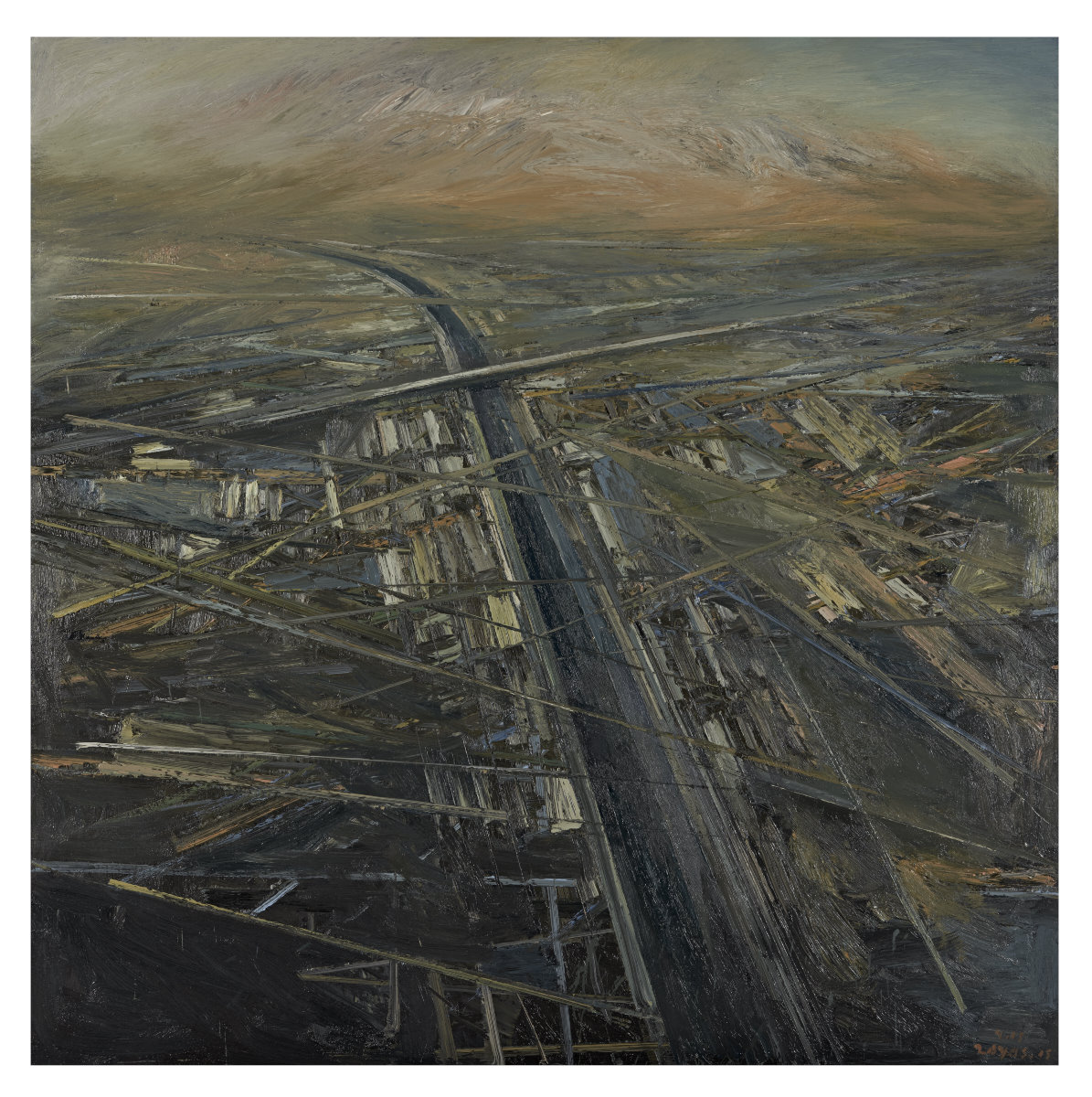
VICTOR HUGO ZAYAS: THE RIVER PAINTINGS
Essay by Wade Graham
MOLAA’s solo exhibition of the work of Victor Hugo Zayas brings together several currents of his work across a range of media, showing the artist’s extraordinary skill at embedding energy and emotion in metal and paint, and his commitment to exploring and revealing the deep structure of place. Zayas’s is an art of transmutations and transfigurations, in which mundane elements of our daily, urban world take on visceral life, and the immaterial is made material. In richly textured masses of paint, air and light take on the qualities of things without ceasing to be ethereal. Stars, points of light in the night sky, become complex, linked geometries, 3D maps of relationships of space. Guns, some once used in violence on the streets of Los Angeles, are crushed into gruesome but evocative debris, then reassembled to become delicate portraits and busts, and poetic evocations of the redemptive power of art.
As its title suggests, the exhibition is dominated by paintings: urban landscapes, most of which he painted in and around his studio on the banks of the Los Angeles River. Taken together, they constitute a time-lapse portrait of Los Angeles, made over more than two decades, each a frame recording a moment in the artist’s and the city’s evolution. Like any landscape artist, his major subject is defined by place—mostly by the industrial neighborhood of warehouses, factories, and rail yards northeast of Downtown L.A. where he has long lived and worked, split by the concrete channel of the river and stitched and seamed by freeways, bridges, roads, railroad tracks, and power lines. This is the city’s infrastructural heart.
Selected from separate but overlapping and intergrading series painted from 2013 to 2015 (the Grid and L.A. River series), plus a number of precursors dating back to the early 1990s, the paintings range widely through degrees of figuration and abstraction, effects of color and of chiaroscuro, and the broad terrain between expressionism and impressionism, forming a protean record of the river and the city, in compositions of trees, concrete embankments, bridges, power pylons, buildings, and transportation corridors, all bathed in a vivid, changing sky. Paint is the fundamental element: raw, confident brushstrokes and thick impasto, laid down in layers and drifts, giving the canvases a dimensional surface and an insistent materiality. The effect is a rare power to capture mood, movement, and vectors of force, and to convey emotion—in a static medium. Flat surface becomes depth: concrete, buildings, dirt, water, and sky seem to move, become animate, foliate, sometimes chaotic, as in the stormy seas in Salsipuedes, 2014 (collection of David Madison). Or, in Verde, Grid series, 2012 (private collection), the sky is roiled by furies of fire reflected in the clouds. Most superlative is the light: Zayas sees it plainly and renders it so that the viewer can, too: the gauzy refraction of Southern California’s marine layer, the gloom
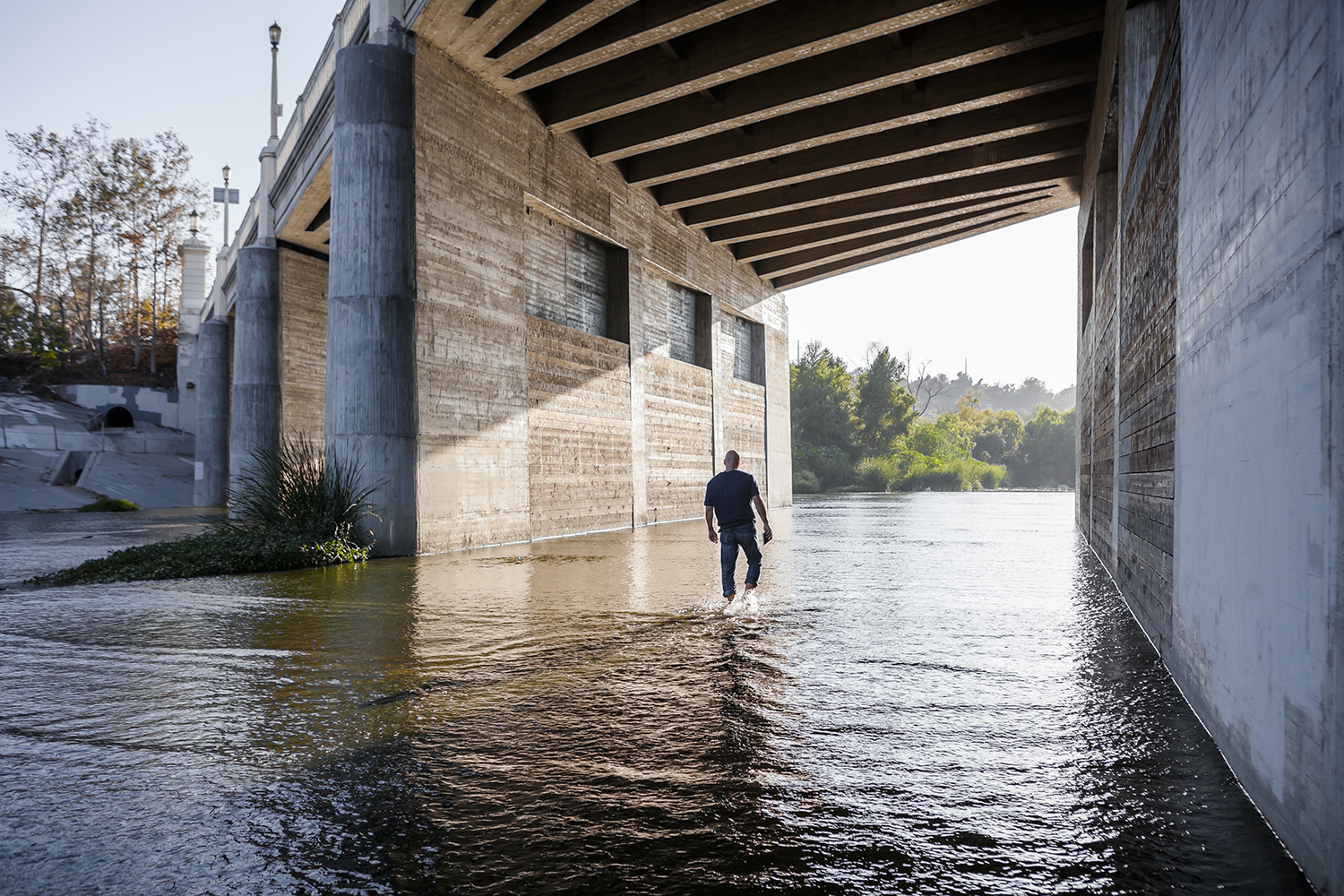
of winter clouds, the ironic aesthetic pleasures of our region’s air pollution—the dirty smoggy browns of midsummer, too-vivid orange sunset skies, and preternatural glows of the city at night. The light, captured in heavy, swirling layers of oil, captures the city’s moods, stresses, and sometimes, sublimity.
Zayas was born in Tijuana, Mexico, and grew up in the West Coast city of Mazatlán. He came to San Diego in 1977 as a high school student, continuing on to receive his BFA there at United States International University. In 1981, at the age of 18, he set off for Europe, with only enough money for two weeks, yet intent on making his pilgrimage to the great repositories of Western art. At the end of the first week, on the Costa Brava in Spain, he donned his swim trunks and took to the beach, painting plein air watercolor landscapes which he sold to passersby. “I stayed alive for six months, just doing watercolors,” he said. And he traveled. He saw Velásquez and the drawings and “black paintings” of Goya at the Prado in Madrid. Elsewhere he saw Rembrandt, Titian, Whistler, Turner, Çezanne, Monet, Van Gogh, Picasso, Soutine—some of the artists he has cited as major influences, visiting every major museum in Europe below its northern tier. It was a life-changing experience—seeing the work in person, and earning his bread with his brush. “I knew I wanted to do this for the rest of my life, but it put a stamp on it, it gave me permission.”
Back in California, he continued his education at Art Center College of Art and Design in Pasadena, graduating with a second BFA in 1986. While teaching art at Loyola Marymount University, he worked on mostly geometrical abstractions in acrylic. The work was strong enough to attract the influential gallerist Jan Turner, who offered the young unknown a one-man show, in 1991. But in the months before the show was to open, Zayas found himself drawn outside, into the area he was then living and working in: the old industrial district northeast of Downtown, along both banks of the L.A. River, with its freight trains, overhead power pylons, and 24-hour transformations of light—from blasted white daylight to the contrasts of yellow sodium lamps against night shadows between the blank-sided buildings. He explained: “It was just my neighborhood, and I went out and painted it. It reminded me of London—foggy, romantic, with the railroads and the L.A. River.” The parallel points directly to the working riverscape of J.M.W. Turner’s Chelsea Reach, of the Thames in the 19th century, and helps explain Zayas’s turn to oil paint and to figurative landscapes in the late 20th, and to painting outdoors, often at night. He worked furiously, sometimes making three paintings in a 24-hour period. Three weeks before the show, Jan Turner came to the artist’s studio, where he had 90 pieces ready, the majority of the landscapes. She said simply, “These are so much better,” and so they, not the acrylics, were hung.
He trained his eye and his hand, filling hundreds of sketchbooks, thousands of sheets. After the random murder of one of his teachers, Dwight Harmon, he recoiled from the conventional art world, and from 2005−2007 rented a studio in South Central L.A., in one of the city’s most violent neighborhoods, operating a small café and teaching drawing classes for local kids. His process was always foremost, of engagement with what was around him. In the middle of L.A.’s worst gang violence, the era of movies like Colors and Boyz in the Hood, Zayas practiced plein air painting, hauling large canvases to the concrete riverbank and painting in the back of a pickup truck, with a baseball bat at his side. He was threatened by gang members, and once shot at while painting on his rooftop at night in the rain, with an umbrella and a light reflector, from a car driving across the First Street bridge over the L.A. River. Bullets cracked the concrete next to him. After taking a break to calm his nerves with wine, he finished the painting that night. His then-neighbor in the Brewery complex, the artist John McCracken, said wryly, “Everyone’s a critic.” Neither critics nor bullets would keep Zayas from making his art, his way.
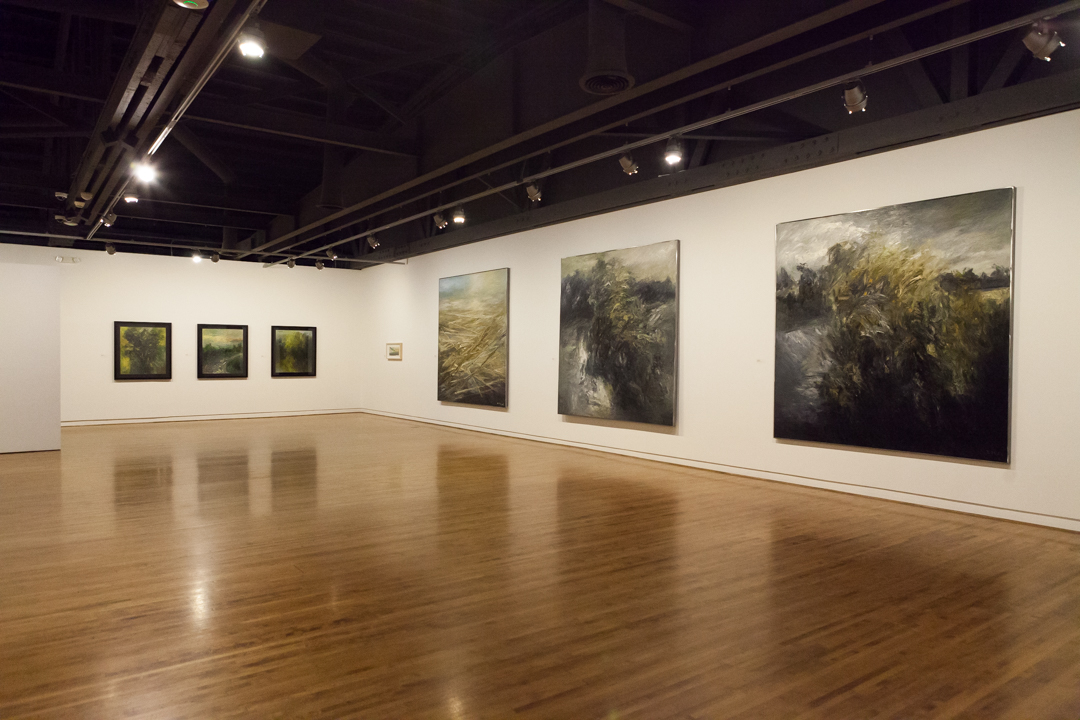
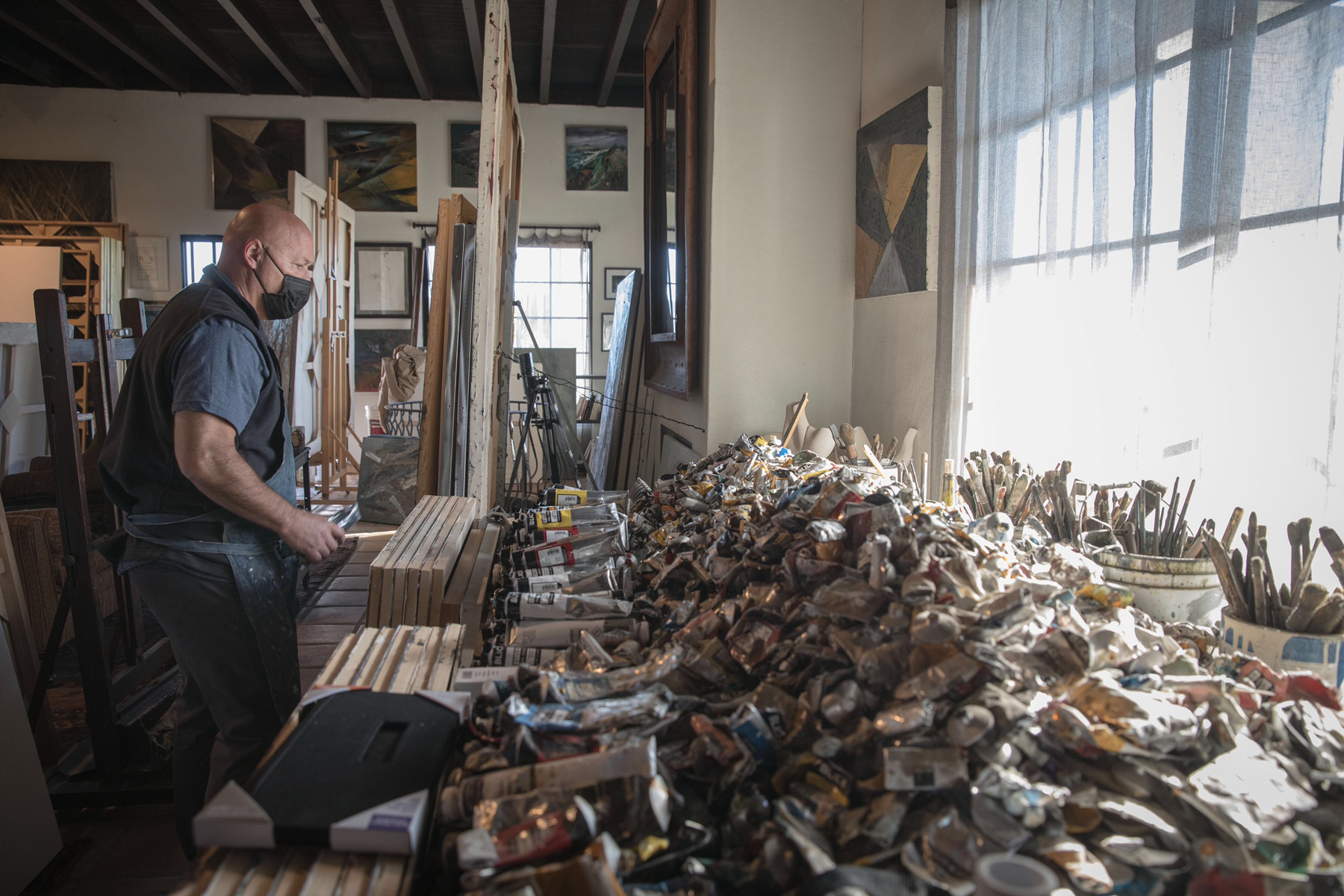
In between teaching and living in L.A. there were trips to work under other skies: to Mérida, in Mexico’s Yucatán Peninsula, where he painted landscapes of dry riverbeds and stands of trees in twilight; a nearly two-year residence on a remote ranch in the state of Michoacán, an area without light pollution, where he read books on astronomy and made studies of star formations, drawing while looking through a telescope. Then he translated the drawings to a series of welded metal sculptures he called “astrophysiological sculptures” made of oblique lines, “connecting the dots,” and giving two-dimensional constellations three-dimensional, physical form.
These and other Mexican artistic experiences, to say nothing of his own personal and family heritage, reinforced his respect for that country’s artistic wellsprings. The influence of Rivera, Siquieros, and Orozco isn’t hard to spot in the work—in his often dark palette, disregard of academic stylistic norms, and confrontation with physical reality, with the city as a stage for a hard-edged urban landscape and the human figure. Zayas is, in one sense, a Mexican artist, but he is equally an American one; irreducibly, he is a Los Angeles artist, practicing a fusion of styles across an astonishing range of media. It has been suggested that he is more a sculptor than a painter. Though this is a needless distinction, one can see the justice in the suggestion, insofar as his sculpture and painting alike are aimed at multiplying dimensions: the star sculptures by exploding the earthbound watcher’s view of a constellation by building it in three dimensions; the paintings by revealing the three-dimensionality of space by capturing its dynamics and energy in paint.
It is a profoundly Modernist mission, and a Cubist activity—yet achieved without any need to reference the standard moves of those categories and periodizations.
In fact, what is most striking about Zayas’s career is how unconcerned with the canonical and its tight, single-file marches he is. His art is based on observation and practice, not on theory or pre-formed intention. “I’ve always been attracted to the abstraction and the unknown in painting. I like to discover a new approach, not by looking for it but by exploring through work. I kind of just stick with it and let it take me where it wants to go.” His is a career guided by experimentation, trial and error, and persistence—which accounts for the wide range of styles and command of different media he has developed. All are roads to go down, excuses in some sense, to experience life the way he does— “visually” in his word—through making art. Just as his brushstrokes capture movement and the serial nature of his efforts describe sequences in time, so does the range of styles he deploys bridge history, enfolding an unfenced array of influences and lessons learned: the luminosity, chiaroscuro, and social realism of the Dutch and Spanish masters, the gesture-made moods of Turner’s riverscapes, the roiling furrows of Van Gogh and Munch, the distorted, expressionist animation of Soutine and Schiele, added to by the flatter geometries and chalky colors of Richard Diebenkorn, another painter of L.A.’s light and mundane urban surfaces who Zayas has learned from, and whose influence is felt in parts of the Grid series.
Suffusing all of the work is an unrestrained romanticism, a celebration in paint of the aesthetic and emotional potential of the city and its stacked and layered physical forms and shifting moods.
One recent chronicler of the urban form of Los Angeles wrote that “infrastructure is the only theology that really took hold in the American West.” Nowhere is this more true than in Los Angeles, and no Los Angeles artist has explored this fundamental fact more than Victor Hugo Zayas, while living for 29 years within sight of the L.A. River, including 6 years at his current studio, a cavernous metal shed hard up against the railroad tracks perched on the east bank, steps downstream from the Main Street bridge, across from a sprawling Department of Water and Power electrical yard and kitty-corner from a cement plant serviced by an endless file of mixer trucks. Inside, the booming engines and horns of slowly passing locomotives and the rattle of rail cars regularly shake the walls and drown out conversation. Hundreds of works, sculptures cheek by jowl with paintings hanging from the high metal ceiling and stacked against every wall, record his engagement with, and interrogation of, what he sees every day: industry and infrastructure, power lines, bridges, lights, warehouses, locomotives, trucks, and always, the concrete flood control channel that replaced the Los Angeles River. Here is the true history and substance of L.A.: how it came to dominate California and the West Coast in a location unfavored by nature—walled off from the rest of the country by soaring mountain walls and vast deserts, without perennial water, timber, coal, or harbors—by ruthlessly building what it lacked: aqueducts to bring water from hundreds of miles away, railroads and seaports to connect it to the rest of the continent and the world, distant powerplants and transmission cables to light it, the world’s most massive highway network to sew its thousands of square miles together, and most recently, airports and the largest train, truck, and warehouse distribution complex in North America, to re-tool its regional economy from factory production to post-industrial global logistics hub. All of this allowed, and continues to allow, Southern California’s “growth machine” of land developers, banks, brokers, politicians, and administrators to pursue the region’s main line of business—selling real estate on an epic and seemingly unending scale. Infrastructure has been the source of L.A.’s wealth and its physical reality—and is the map of its limitations.
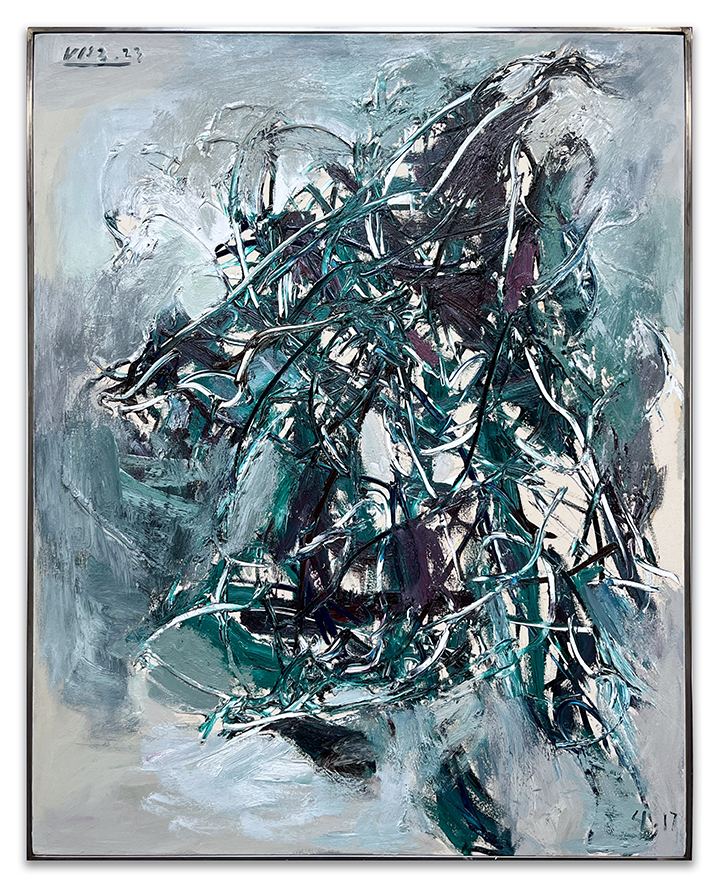
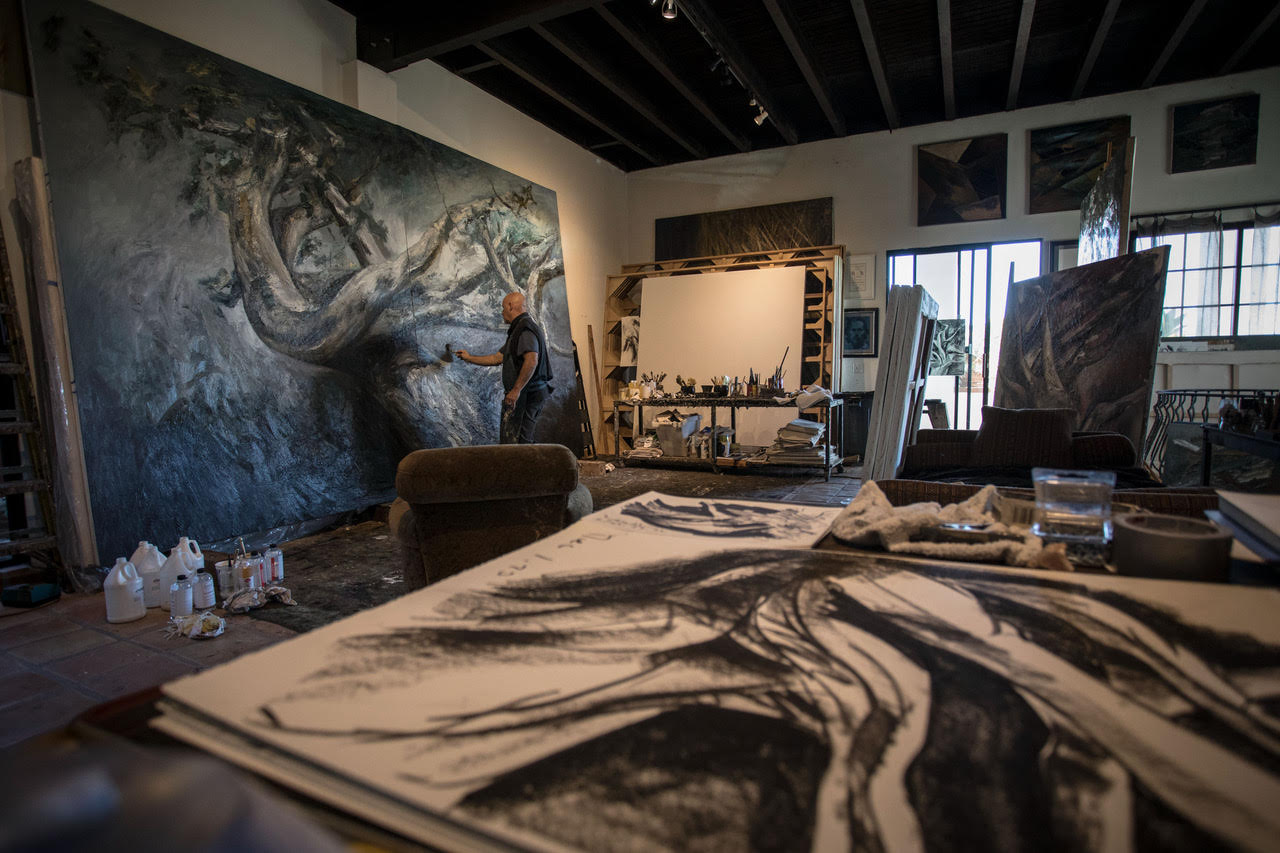
In recent years, the L.A. River has been transformed, in part by the attention and efforts of serious artists living and working next to it. It has gone from being a joke (What is the indicator species of the L.A. River? A shopping cart.) and the resort of the homeless, gangs, and graffiti artists, to emerging as the central strand in the city’s attempt at remaking its self-identity in a paradoxically “green” mode. Billions are set to be spent upgrading it, possibly “restoring” it—though to what earlier state is an open question, as the River is far less a natural phenomenon now than a cultural one, and above all, unavoidably, an infrastructural one. It remains an indispensable flood control channel, without which millions of people in L.A. County could not live and work where they do. In the winter rainy season, the river remains dangerous, capable of flooding out tens of square miles of a city unprepared for its occasional violent surges. In the long summer it is a rare note of flowing water in a drought-stressed region—even though its flow in the dry season consists almost entirely of treated sewage. California’s latest four-year drought has only intensified the spotlight on the need to reassess the River’s role in keeping Los Angeles habitable. It is now at the center of the question of our survival in this volatile place—a landscape equally capable of drought and flood, just as it is of horrific violence and arresting, sometimes appalling beauty.
Zayas lives with the River as an enormous visual fact, but also a partly inexplicable one—and thus an enduring object of fascination, as it is for so many Angelenos who know of its different reaches and paradoxes, its expanses of concrete and trickles of water alternating with churning and deadly brown floods close to over-topping the banks. He has painted the River in its many incarnations and moods for more than two decades, mirroring the city’s growing fascination with its strange watercourse and changing relationship to it. Starting from the River corridor and extending along its power line and road-laden bed, downstream along the 710 freeway to Long Beach, a truck-choked ribbon which he habitually traverses in a gray Toyota pickup en route to points south, including his family home in Baja California, he began to see Los Angeles as a region. His most recent paintings address Los Angeles County‘s presence as a global city, the logistical hub and point of entry for 40 percent of the goods shipped into the United States and a crossroads for people and ideas from everywhere. The Grid series captures this overwhelming visual reality as traces of movement: crossing contrails, streaks of freeways and railroads, almost-solid masses of air, smog, fog, and light, all in endless permutation.
The vantage point is above the city’s surface: a long practice of the artist of painting from rooftops or ridges in nearby Elysian Park at night to capture lights (as in East Los Angeles, 2004, in this show), which was reinforced more recently by an experience of flying into the city over its endless, torquing grids—captured in the painting LAX, 2012, which began the protean Grid series seen here in full flower.
In these skies is an almost-photographic record of the city’s connections and connectedness, its human and mechanical hum and thrum. In the riverscapes is a testament to its insistent natural vitality: clumps of willow trees twist and lick upward like wind-driven flames, some turned the burnt yellow-orange of winter—reminding that L.A. indeed has seasons. The canvases, along with the sculptures, are the products of a mature and confident artist whose commitment to his practice and engagement with his surroundings has formed a body of work that must be recognized as a major achievement.
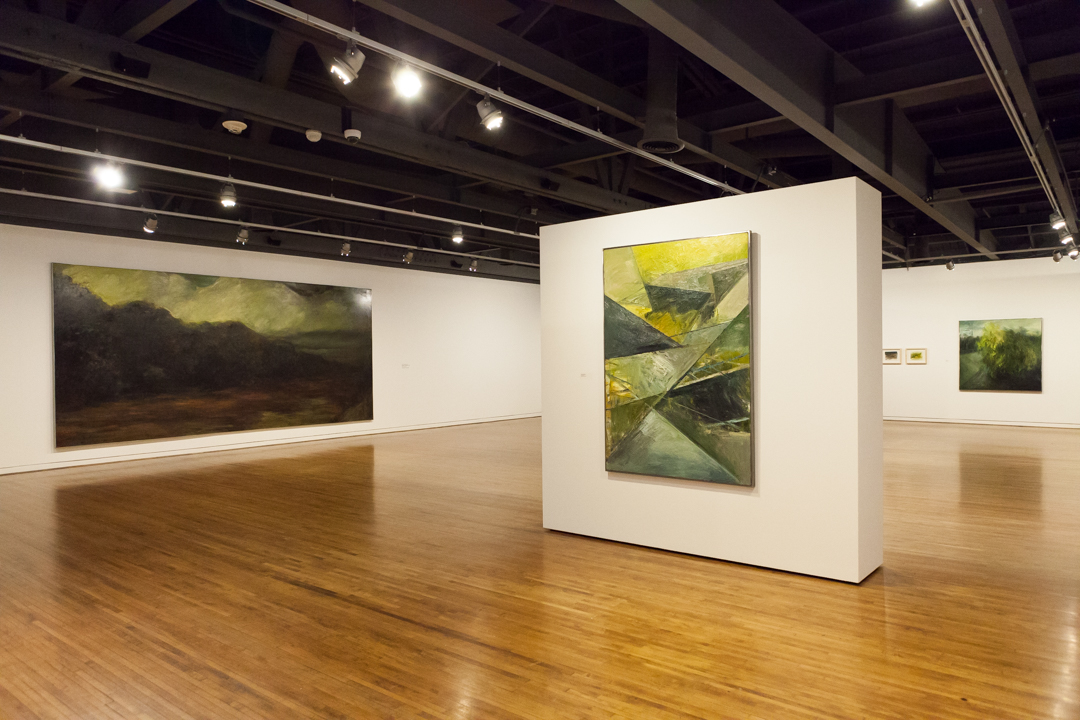
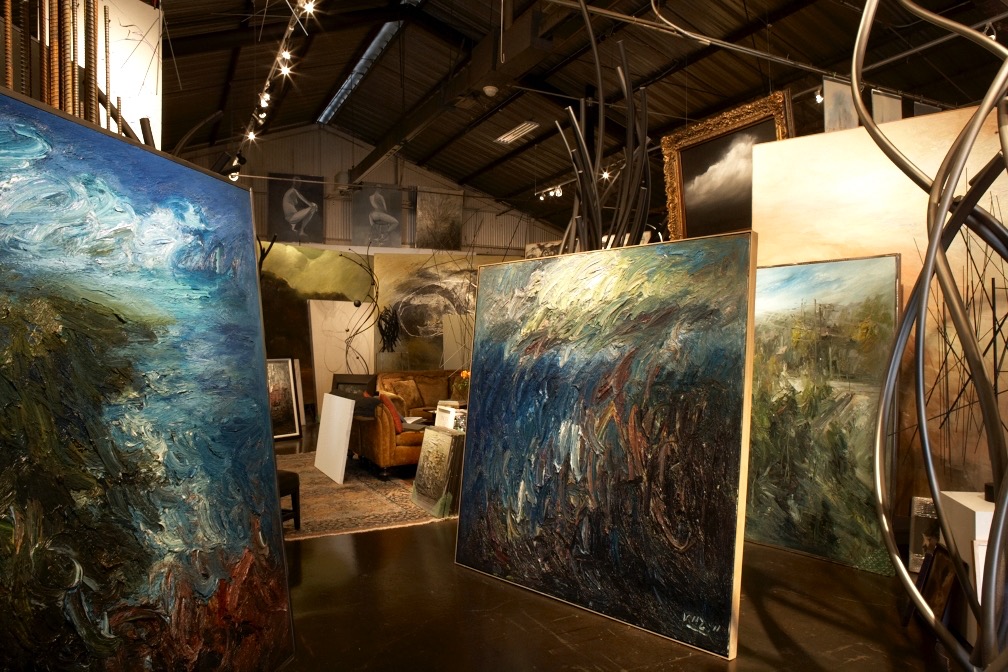
Wade Graham is the author of a social history of gardens in America, American Eden: From Monticello to Central Park to our Back Yards, What Our Gardens Tell Us About Who We Are (HarperCollins, 2011), and the forthcoming book Dream Cities: Seven Urban Ideas That Shape the World (HarperCollins, Jan. 26, 2016). He has written on the environment, landscape, urbanism, and the arts for The New Yorker, Harper’s, The Los Angeles Times, Outside and other publications. He is an adjunct professor of public policy at Pepperdine University. Since 1999, he has been a trustee of Glen Canyon Institute, a Colorado River restoration group based in Salt Lake City, Utah.
